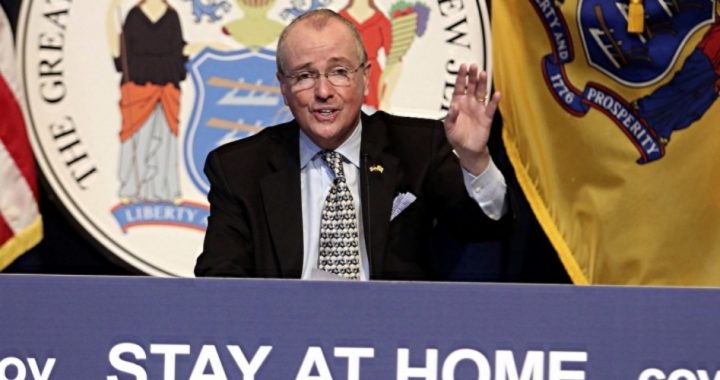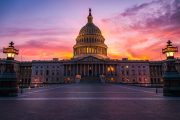
Perhaps he’s competing with Gretchen Whitmer (D-Mich.) for the Worst Governor in the Nation title. But New Jersey’s Phil Murphy (shown), who recently shrugged off his civil-rights violations by saying the Constitution was above his “pay grade,” is now proving that science is, too:
On Monday afternoon, the governor announced a plan that essentially extends his state’s coronavirus stay-at-home order indefinitely — even though it’s now clearer than ever that the “lockdown” strategy is a cure worse than the disease.
Nonetheless, “New Jersey has been on virtual lockdown for the past five weeks, with all schools and ‘non-essential’ businesses closed,” Politico relates. “About 860,000 New Jerseyans have filed for unemployment since the pandemic’s onset early last month, and some Republicans are clamoring for the governor to allow a limited reopening of the economy.”
Yet as a prerequisite for doing so, “the state would need to see several measures of the virus’ spread consistently decline over 14 days, including positive test results and hospitalizations, Murphy said,” Politico also reports. “While the daily reports of new tests results have remained largely constant for the past several weeks, the number of hospitalizations has been trending down, particularly at facilities in the state’s northern and central counties.”
Fox 5 New York provides a summary of Democrat governor Phil Murphy’s plan:
The roadmap he announced included six principals [sic] called The Road Back.
1. Sustained reductions in new cases
2. Expanded testing and speedier results
3. Implementing robust contact tracing
4. Securing safe places [where] people who are diagnosed in the future can isolate
Under expanded testing, Murphy said that the rate of testing would need to at least double in the state. He said that would not happen before the end of May.
He said after the first four steps are met the state could move on to the final steps.
5. Responsibly restart the economy
6. Ensuring resiliency in the future
Now, how the governor arrived at this plan is a mystery. Maybe Princeton Phil sees his shadow and concludes there should be six more weeks of economic winter. But some might say, as American Thinker did, that the “14-day” standard is “rigged.”
As that site avers, increased testing “almost certainly means that even if the real curve of the number of newly infected in a state has leveled off, the change in the daily testing volume and the huge pool of asymptomatics and others testing positive with the antibody test available for testing will provide a big boost to case counts and drive them up. It could also drive up the positivity rate if many of those who tested positive with the antibody test had the virus a while back.”
“As a result, this will cause states to delay ending their strict quarantines and partially reopening their economies, since the number of new positive cases reported each day is going up, rather than down,” American Thinker continues.
But don’t tell the Branch Covidians (hat tip: the American Thinker commenter using the characterization). To them, the Covid-19 lockdown strategy is now an article of faith, despite new data such as the recent study showing that states and countries not locked down are doing at least as well as those that have adopted the draconian measures.
In other words, the research indicates that lockdowns don’t save lives.
One man who predicted this was Professor Knut Wittkowski, the former long-time head of the Department of Biostatistics, Epidemiology, and Research Design at the Rockefeller University in New York City. He stated early this month that the Wuhan virus could be “exterminated” in weeks if we merely allowed people to behave normally and establish “herd immunity” while isolating and protecting vulnerable groups.
Note here that the vast majority of those contracting the virus are asymptomatic or experience only mild symptoms, and studies are beginning to show what cooler heads have long theorized: The disease’s mortality rate may end up being similar to that of the flu.
Consider also that Sweden never locked down, and its herd immunity strategy appears to be working, as the graph below provided by Kentucky State University assistant professor Wilfred Reilly indicates.
Social distancing is important, and crazy loose talk should be avoided…but it’s worth remembering HOW wrong the COVID models were (due to decreased lethality, etc.). This, from @theblogmire, is an exact mapping of Sweden’s actual death rate onto Imp-College’s predictions. pic.twitter.com/iMZ9m4DGa3
— Wilfred Reilly (@wil_da_beast630) April 23, 2020
Even Fox News host Tucker Carlson, who once had taken a rather alarmist Wuhan virus position, reported last night that there is no scientific justification for extending the lockdowns (video below; excellent information).
In reality, this disease could perhaps be called the Wizard of Oz Virus: Its reputation greatly exceeds its power. Sure, it is deadly to vulnerable groups (which should be protected). But so is the flu, which killed 61,000 Americans during the 2017-18 winter season alone. Moreover, the 2009 flu pandemic claimed the lives of 358 children, according to the CDC. And the Wuhan virus?
The CDC reports that 1.7 percent of the cases have involved those younger than 18 (as of April 6) — and there might have been three deaths.
Oh, and they’re unconfirmed.
Why didn’t we shut down the schools every flu season?
Meanwhile, our Wuhan-flu frenzied Wizard of Oz leaders wanted to “flatten the curve” and have certainly succeeded in flattening the economy, which brings its own health risks and poverty-related mortality (as the cartoon below colorfully illustrates).
Ask Fauci to model this. What will be the death rate of mass-starvation? 10%? 20%? 60% or higher due to an economic collapse? What ever it is I’m sure it’s much much higher than the 1% or less due to COVID-19 pic.twitter.com/ZZjt5jCYnK
— A.F. Branco Cartoons (@afbranco) April 27, 2020
But Princeton Phil the Branch Covidian would disagree. He said when justifying his lockdown strategy, “We only want to have to do this once.” Well, maybe reading news is also above the governor’s pay grade, but scientists claim there could be thousands more Wuhan-flu-like viruses lying in wait. So how many times will we “have to do this once”?
The answer could be zero — if not for politicians and people afraid of their own shadow.
Photo: AP Images
Selwyn Duke (@SelwynDuke) has written for The New American for more than a decade. He has also written for The Hill, Observer, The American Conservative, WorldNetDaily, American Thinker, and many other print and online publications. In addition, he has contributed to college textbooks published by Gale-Cengage Learning, has appeared on television, and is a frequent guest on radio.




